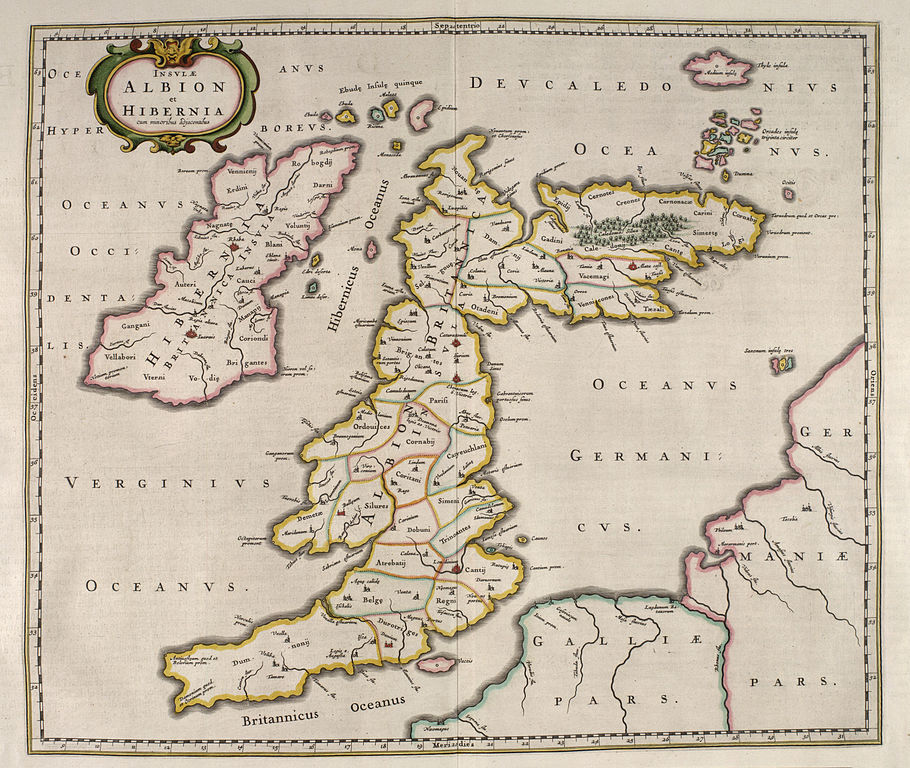
Insulae Albion et Hibernia, 1654 Source
This article is part one in a series that follows a long chain of events whereby the land of Albion was lost forever. Albion was the ancient name for the British Isles as attested by the Greeks from around 6 BC. Celtic linguist Xavier Delamarre, claims that it originally meant "the world above, or the visible world", as opposed to "the world below", i.e., the underworld, namely Annwyn (please note: NOT Hell - that was a Christian concept which they associated it with later.)
The name ‘Britannia’ or ‘Britain’ was a later development that came after the supposed Roman Conquest (although this is a highly contentious subject.) This was the beginning of the end for the land of Albion. These days Albion is a myth, a legend, just a computer game. Our historical knowledge of it is based upon legends, butchered to satisfy The Church and the egos of monarchs and nobles who all wanted desperately to be justified as its legitimate rulers regardless of their worth.
Albion belongs to The Old World. The greatness of ‘Great Britain’ can never match that of Albion. It lives on in people’s souls where it couldn’t be crushed by the onslaught and betrayal it was so ill-equipped to withstand.

Insulae Albion et Hibernia, 1654 Source
(This section is a later addition by Will Scarlet.)
The history of London and indeed The British Isles themselves, is a complete and utter mess. As usual, there have been copious attempts at discrediting and misrepresenting anything inconvenient, but on a massive scale. The result of this has been to totally smother any genuine events under a suffocating blanket of myth, legend, fiction and downright lies. To attempt to recussitate the truth goes far beyond the scope of this article. However, there is one part in particular that is highly relevant and that sheds a harsh light upon a hidden agenda. Before we begin, let’s examine some of the more popular and completing theories concerning the City of London.
“At St Dunstan-in-the-West I go and stand by the statues of King Lud and his sons Androgeus (who is possibly Mandubracius king of the Trinovantes in modern day Essex and East London) and Tenvantius (who was king of the Catuvellauni in today’s Herts/Cambs/Beds).
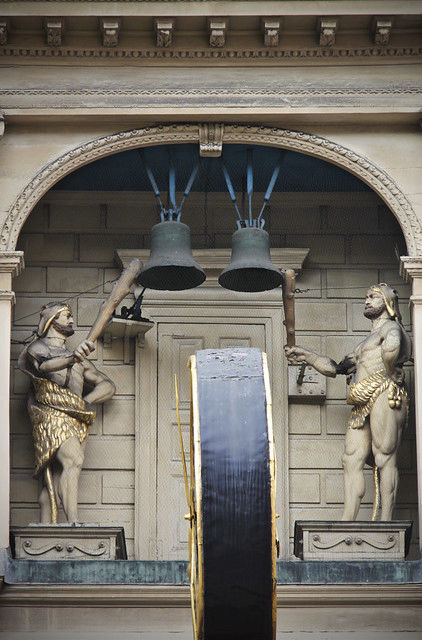
Gog & Magog, St. Dunstan's-in-the-West. Source
“According to a legend set down in Geoffrey of Monmouth’s History of the Kings of Britain, Lud is credited with building, or at least expanding, a grand citadel on the hill where St. Paul’s Cathedral now stands, a hill that bears his name – Ludgate Hill in the period just preceding Ceasar’s first expeditions to Britain in 54BC. He was buried at the foot of the hill where the Lud Gate stood and the 14th Century statues at St. Dunstan’s used to adorn the gate until it was demolished in 1780. Some legends say that London is named after Lud*, one of the many competing foundation myths.
“Another can be found high up on the face of the church where the statues of Gog and Magog toll out the half-hour and hour standing camply one hand on the hip the other on their vicious looking clubs. According to myth they were the ancient British giants defeated by Brutus the Trojan who then established the first city of London in 1180 BC.
‘In the year 1108 B.C., Brutus, a descendant of Aeneas, who was the son of Venus, came to England with his companions, after the taking of Troy, and founded the City of Troynovant, which is now called London. [one thousand years later] Lud became its king. He built walls and towers, and, among other things, the famous gate whose name still survives in the street called Ludgate’. This is how Walter Besant recounts Geoffrey’s myth in his History of London published in 1893 before stating that it is if not an invention it’s a mangling together and miss-copying of prior sources to construct a grander yarn.” Source
[*King Lud (73 BC), fortified the city and annexed lands to it, and re-named it "Caer-Ludd" (Lud's Fortress or Town). It later became known as Kaerlundein and finally the Saxons called it London.] Source
Geoffrey of Monmouth and his History of the Kings of Britain, is almost universally loathed, despised and derided as being a sycophantic attempt at ingratiation to the ruling monarch of the period and therefore, largely fictional. It comes from a time when oral traditions were being committed to the written word and more importantly, a time of intense Christianisation when a great many documents were burned, ‘lost’ or copied and distorted. For me personally, this adds credence to it. Geoffrey claimed that Gogmagog was a giant (one single giant) who attempted to repel the invasion of Brutus and his fellow Trojans, but there are many confusing accounts of Gog, Magog and Gogmagog as we shall see.
"Manley Pope, author of an 1862 English translation of the Welsh chronicle Brut y Brenhinedd (itself a translation of Monmouth's "Historia Regum Britanniae") argued that it [Gogmagog] was a corruption of Gawr Madoc (Madoc the Great.)" Source
Presumably the same Prince Madoc who sailed to America in 1170 and set up a colony, however, this makes a mess of all the timelines.
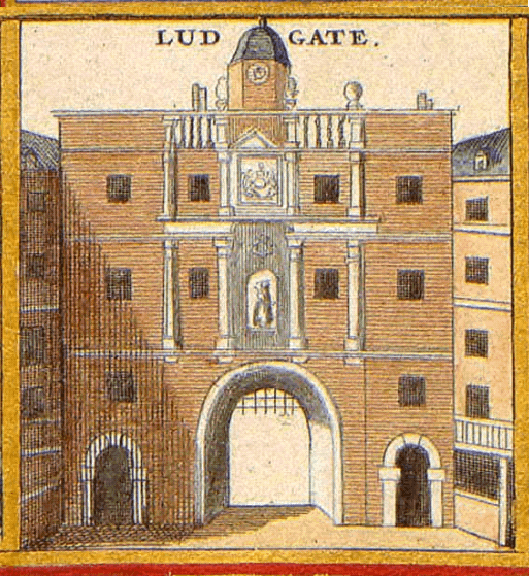
An old illustration of Ludgate circa 1650 Source
“Two giants named Gog and Magog are the “patron saints” or “protectors” of the City of London…. Every year, on the second Saturday in November, they are paraded through the streets of the City.
“This parade is one of the oldest in the world, going back to the 13th century, but the giants Gog and Magog were not introduced until the reign of King Henry V (1386 – 1422).” Source
The names Gog and Magog are mentioned in the Hebrew Old Testament - Magog as the second of the seven sons of Japheth (himself a son of Noah) in Genesis 10 and again in Ezekiel 38:1-4, whereby Gog was “of the land of Magog” against whom the “Son of man”, was supposed to do extreme violence. They are mentioned again as two distinct individuals in the New Testament Book of Revelation (20:7-9) in a passage the confuses tenses and is so difficult to understand that even the so-called biblical scholars can’t agree on it’s meaning.
So, on the one hand we have a presumably ancient Hebrew origin for Gog as an evil person and Magog as a place... maybe the place of Magog, who knows? Then there’s a later New Testament one where they are both mentioned as individual ‘entities’ probably under the command of Satan. As previously mentioned there’s the other Trojan invader ones which claims he or they were the ancient giant or giants of London defeated by Brutus in 1180 BC. There’s a distinct lack of continuity here and which of these is the original?
How then did any of these characters become the ‘protectors’ or ‘champions’ of London?
To illustrate this I will borrow a famous quotation by Charles Dickens from his Ebenezer Scrooge character in the book ‘A Christmas Carol:’
“Bah! Humbug!”
What follows comes from a book published in 1819 entitled ‘The History of Gog and Magog, the Champions of London’, by Robin Goodfellow - obviously a pseudonym. This was another name given to Robin Hood and also applied to Puck, the Fae character from Shakespeare’s ‘A Midsummer Night’s Dream’.
It should be born in mind that the so-called privileges granted to the City of London are claimed to be so old that they pre-date history itself and therefore no written Charter exists granting them. This will be illustrated by Felix later in this article.
Robin Goodfellow’s History is set in “a rude age” long before Christian and Roman Britain, although no clear date is given. At this time the prototype London was ruled over by a giant named Humbug, who was a greedy tyrant with gout. He fell in love with a beautiful princess, daughter of the rightful king of the area, whom Humbug had killed. Her name was Londona (I kid you not.)
Unsurprisingly Londona rejected Humbug’s amorous advances, so he ended up kidnapping and imprisoning her in his castle. Twin sons of a local miller, Gog and Magog, were renowned for their bodily strength and also that of their character. Their ‘noble indignation’ at the news of Londona’s capture prompted them to raise an army of rebellion. Swords had not been invented at that time so they used clubs and shields.
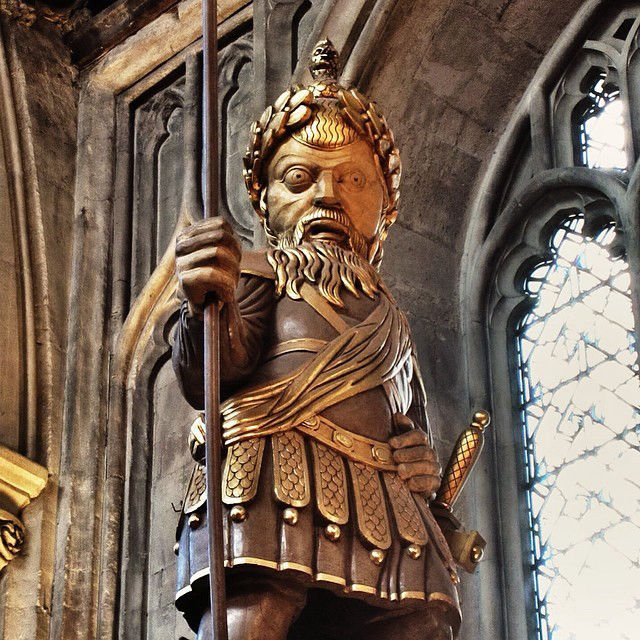
Gog, The Guildhall, City of London... with a sword. Source
After much fighting and the creation and fortification of the Tower of London, by the twins, an attempt was made to storm Humbug’s castle. Humbug had his own troops who fired arrows at the rebels. Humbug threatened to hang Londona from the parapet of his castle unless Gog and Magog submitted to him. Following negotiations, they agreed to exchange themselves for Princess Londona… which is odd as Humbug didn’t need to negotiate at all, unless he fancied the twins more than the princess.
The exchange took place on the 9th November (by whose calendar?) “a day annually commemorated by the Lord Mayor resigning the magisterial functions to his successor; a ceremony instituted to keep up to all posterity the memory of the deliverance of Londona.” Who meanwhile raised an army to attack Humbug. After a series of highly unlikely events, Humbug was killed and Gog and Magog were freed.
A celebratory feast ensued, "after supper, on the cloth being removed, and Non Nobis sung with great effect, she filled a bumper, and proposed as a toast--The health of Gog and Magog.” In spite of the fact that this was at a time before Christianity and before the Roman invasion, a Non Nobis is “the incipit and conventional title of a short Latin Christian hymn used as a prayer of thanksgiving and expression of humility.” Source
The following day, Londona decided to build a capital city and name if after herself – Princess? No, London of course! “She thought the families who had taken refuge within the fortress of her gallant deliverers, should remain on the spot, and become the first inhabitants.”
“She accordingly declared, that those who had united themselves to the enterprise of Gog and Magog, should be distinguished from the rest of the inhabitants as her special vassals; by which, in the process of time, they came to be known as the liverymen of London. To these, as they were too numerous for purposes of business, she gave authority to elect a certain number of the most intelligent members of their body to form a council ; and out of this institution grew the now far-famed common council of London.”
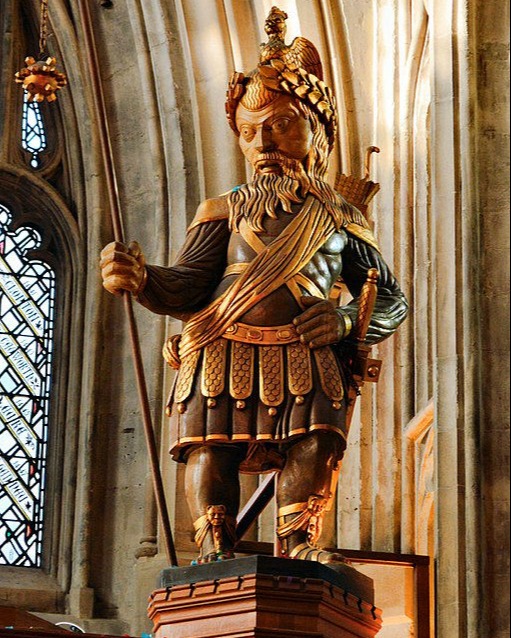
Gog, The Guildhall, City of London... also with a sword. Source
From out of this organisation the elder men became the ‘aldermen’ and one of its first duties was to advise the princess to make a favourable marriage. “Gog and Magog having, in the meantime, been chosen sheriffs for the city and Middlesex, were directed to enquire when the address [i.e. the order to marry favourably] would be received. Hence arose the practice of the sheriffs, on all similar occasions, apprising the ruling sovereign of the city addresses, furnishing, at the same time, a copy, that the Court might have time to prepare a suitable answer.
“The Princess, on being informed of the object of the address, the first from her new city, determined to receive the deputation seated upon her throne. Thus was a precedent established, by which, in time, the citizens of London became possessed of this enviable privilege, which they have ever since claimed, of addressing the sovereign on the throne.” (Not the WC, btw)
As to the Princess’ response, “unfortunately, the folio of the record in which it was preserved, was destroyed in the fire of London... We have, however, had the good fortune to obtain a very curious document, which was lately discovered on removing that part of the ancient wall of the city which formed the scite [sic] of Old Bedlam ; and which, on being, examined by a special committee of that learned body, the Antiquarian Society, appears to have been a manuscript newspaper of the time, entitled ‘The Trumpeter,’ containing a programme of the whole ceremony. It is not legible throughout ; but enough remains, to enable us to ascertain, that it was on this occasion that the title and dignity of "MY LORD MAYOR," was given to the senior alderman: at least it is stated, in the leading paragraph of ‘The Trumpeter’, that the Princess honoured him with the title of My Lord Major.”
No swords, but they had a newspaper. “Newspapers are evidently indigenous to London; for in no part of the world have they grown to such perfection, or contributed in any similar degree, to the enlightening of mankind.” The Princess was “encouraged” to marry Tooley, Prince of Southwark. just across the river Thames. To celebrate this Gog and Magog (NOT giants themselves remember) built London Bridge.
A son ensued from the marriage who was born at the exact same time that “a fine bell had been hung on the bough of a stately tree, which then grew in Cheapside. This bell was called the Bell-of-the-bough, or Bough-bell.” He claims that the later church that was built on the same spot was originally called St. Mary-le-Bough, which is ridiculous. It was a Norman Church and ‘bough’ in French is ‘branche’ or ‘rameau’, but bear with me, it gets even more crazy. The correct name was St Mary-le-Bow, which gave rise to the Bow Bells tradition. This Goodfellow further claims that Queen Londona declared “after that day, every male born within the sound of the bell, should be pre-eminently distinguished over all her other subjects,” but the midwife shut her up before she could say how.
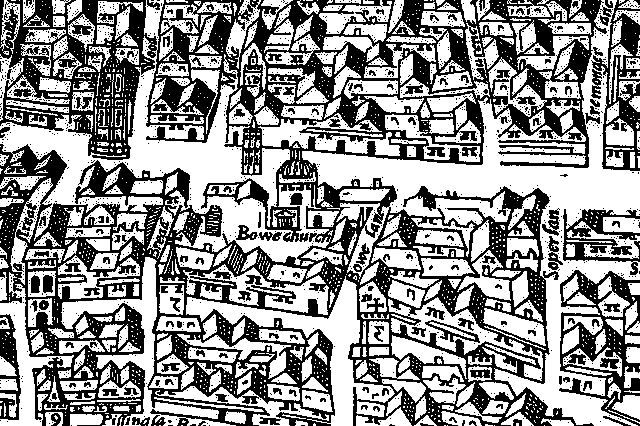
St Mary-le-Bow Church as shown on the
“woodcut" map of the early 1560s
(shown as "Bowe church" - not Bough.) Source
“it was owing to some metaphysical influence of this decree, that the youth of the city of London uniformly maintain extensive pretensions to distinction, without ever verifying the same, it being certain and unquestionable, that, if the Princess had been allowed to mention in what their superiority was to consist they would have proved themselves well able to assert it. For, of all the British youth, those of London are the most distinguished for their talkative capacity; and it cannot be doubted that, with such powers to amuse, they are well calculated to play a distinguished part in every conversation.”
My brother and I (along with many others) were born in a hospital located right on Hyde Park Corner just opposite Buckingham Palace from where we would have been able to hear the Bow Bells had we been born during those quiet traffic-free times, but we didn’t live in the City of London. “The church was noted from medieval times for its arches, hence the name, from ‘bow.'" It’s curious that ‘bow-legged’ is the exact opposite of ‘knock-kneed’. Anyway, it gets even more preposterous:
“When the son of Londona grew towards manhood, it was observed that he was somewhat loosely jointed at the knees ; from which circumstance he came, in process of time, to be called KNOCK-KNEE ; and with that commendable loyalty which induces faithful and loving subjects to name their children after the reigning king or queen, the citizens of London, called so many of their sons after KNOCK-KNEE, that the term at last became the peculiar title of all native youth of London. On the honourable epithet of KNOCK-KNEE, time has not been more sparing than on that of BOUGH-BELL ; for, in the lapse of years, the N has been gradually omitted in the knock, and the K in the knee. Hence the vulgar term of Kocknee ; or, as it is usually written, Cockney, has been substituted.
See, I told you. The actual etymology of ‘Cockney’ is quite well covered here.
“The circumstances attending the death of these illustrious twin-brothers (Gog and Magog)... have not been narrated. The corporation of London having, with that exquisite taste for which it is so justly celebrated, after a long debate in Guild-hall, determined that it was sufficient to record the date of the event.” A couple of statues were erected in The Guildhall at some point and that was it. Effigies of them get carried around the streets during the Lord Mayor’s show once a year, but none of the ordinary people watching have any idea why.
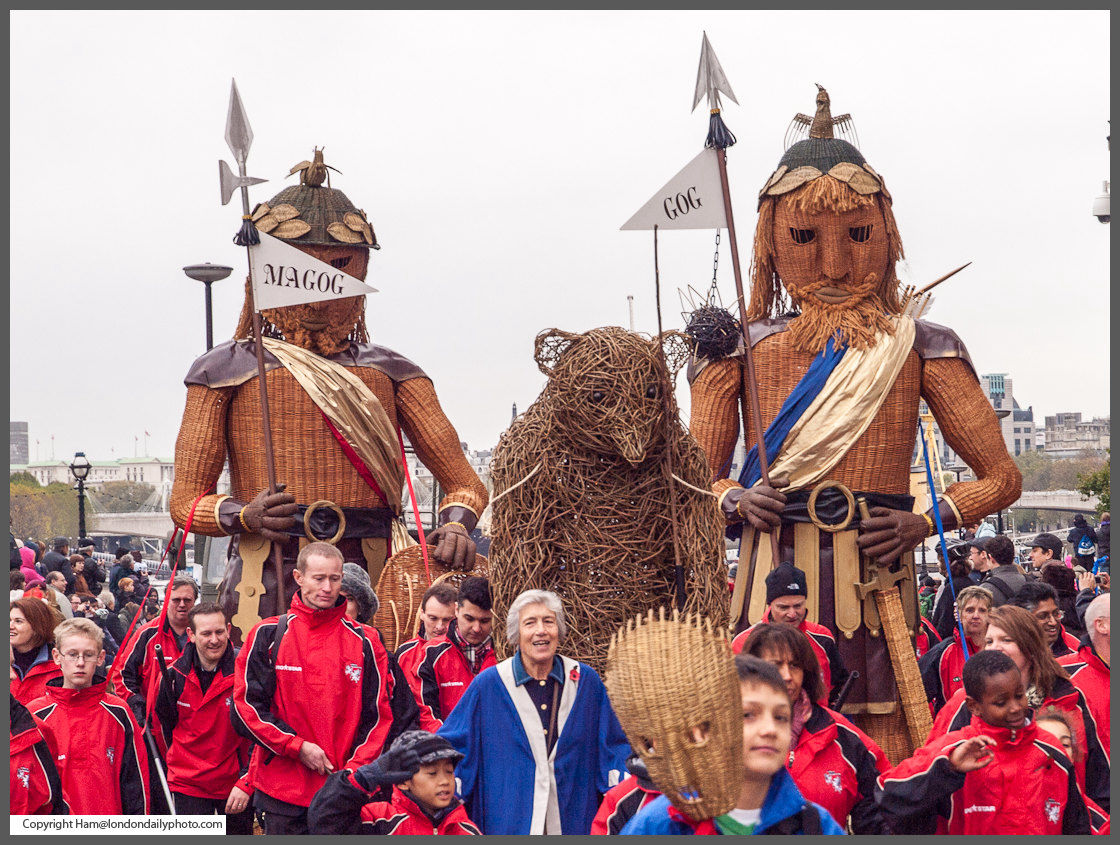
The Annual Lord Mayor's Parade. Source
Humbug – A giant who kidnaps a young girl. Typical fairy tale material. “According to the Oxford English Dictionary, ‘humbug’, is ‘deceptive or false talk or behaviour’ - as in, ‘What you just said was humbug.'
“It could also be used to refer to an act that is intended to deceive and mislead; or as a description of someone who is being willfully false, deceptive or insincere.”
Robin Goodfellow – the goblin or sprite given this name was considered to be a prankster.
Londona – this doesn’t really need any comment does it?
Gog and Magog – entirely unoriginal names and not giants, but they managed to defeat one by stamping on its toe. They are evil satanic entities in most other references to them.
So, is this book satirical? I thought so, but it seems to be genuinely justifying the assumed rights, privileges and ‘traditional customs' of the City of London. It claims to be based upon older sources, but then it would do. It’s all too ridiculous to be taken seriously, but is that the way it would have been judged in 1819 or prior to that date? The point is, if the author is relating information he considers to be true, then he’s as much a victim of the deception as we would be if he was deceiving us. I’ll let the reader decide.
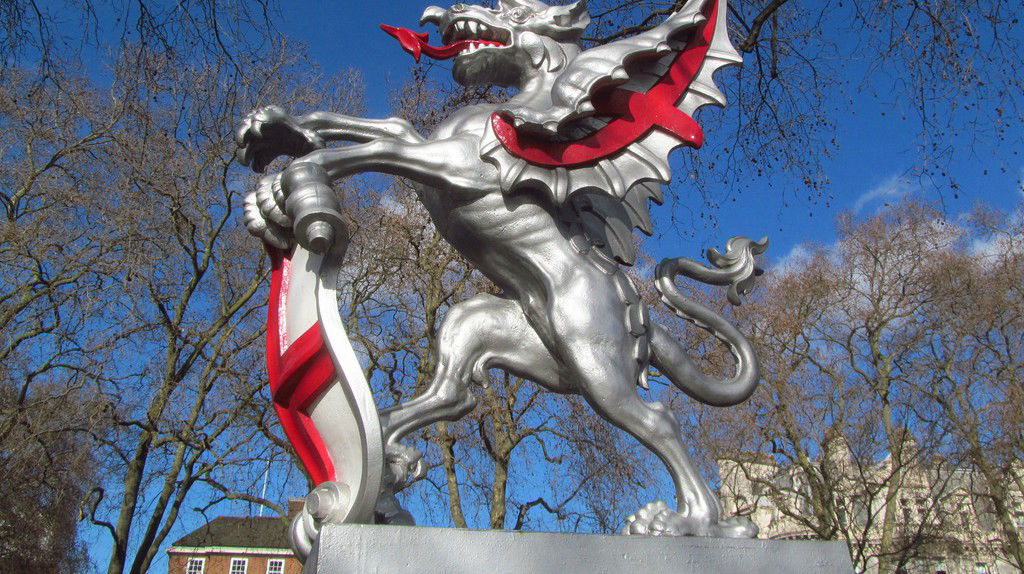
Dragons marking the boundary between The City and London itself Source
The first and probably the most important thing to understand about The City of London is that it isn’t the city of London. The City is a one-square-mile area that was once walled around its perimeter, by those pesky Romans of course, everything else is just London.
“Today the two Londons have separate city halls and elect separate mayors, who collect separate taxes to fund separate police who enforce separate laws. The Mayor of the City of London is known as 'The Right Honourable the Lord Mayor of London' and wears as fancy costume in his golden carriage and works in The Guildhall. The City of London also has its own flag and crest, whilst London has neither.” Source
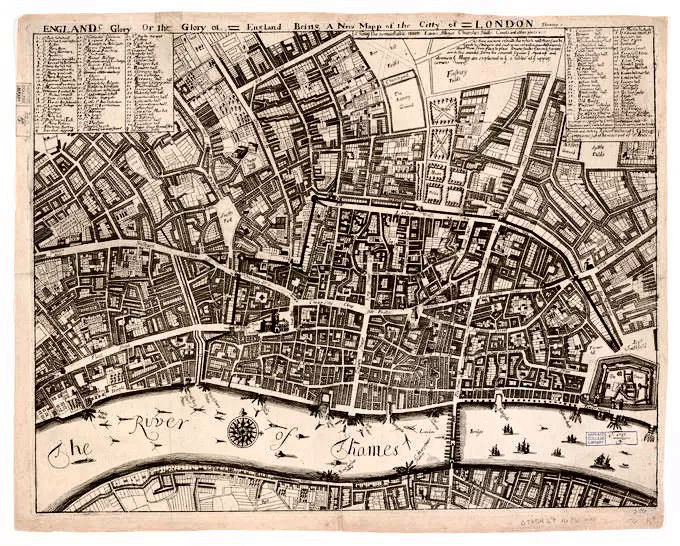
Map of the City from 1676 showing the various guild halls. Source
The corporation that runs The City of London claims to be older than the United Kingdom by several hundred years. William the Conqueror’s excursion to Britain apparently came up against a slight hitch when he discovered The City of London sitting there on the river with its walls, bridge and gates firmly closed. It is claimed that he agreed to recognise the traditional rights and privileges of The City as long as they acknowledged him as the new King. This will be covered in detail in Part 2.
This flimsy and highly unlikely story is the basis of a one-thousand-year long tradition whereby, even today, the mayor of London doesn't have any power over the City of London. It’s generally believed that even the ruling monarch cannot just enter the City, but must ask for permission from the Lord Mayor by means of a weird ritual, although this isn’t actually true.
The City of London also has a representative in Parliament and the House of Lords - The Remembrancer. Today his role is to protect the City's special rights, but in the past it was different. From its inception in 1570 during the reign of Elizabeth I and up until around the time of The Great Fire in 1666, The Remembrancer was just a secretary or archivist to the Lord Mayor – someone who remembers things. Nowadays, thanks to power of The Remembrancer, laws passed by Parliament don’t always apply to the City of London.
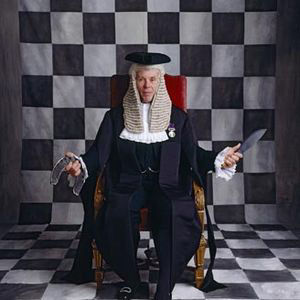
The Remembrancer - note the knife and the Masonic symbolism Source
By the time of Elizabeth I’s reign, the City of London had become an essential part of daily life. It was the busiest port in the country and encompassed all of the facilities, administration and trades for dealing with such a vast movement of goods. “The superior military organization of the City forces—such as the Trained Bands, the Artillery Company, and other kindred bodies—at a time when the standing army was in its infancy, and viewed with disfavour by the people; the riches of the merchants,—which ever offered to the Crown the greatest facilities for borrowing money,—and their extensive trade with foreign countries, necessitating as it did the employment of a vast number of vessels and men, and thus affording in times of emergency a means of rapidly and effectually increasing the navy,—could not fail to enhance the power of the citizens in the councils of their Sovereign.” and breathe, that has to be one of the longest sentences since Charles Dickens'. Source
Between that time and now, something sinister took place and created the monster that is The City of London today.
To understand The City of London it’s necessary to be aware of certain background information… well, quite a bit of background information actually.

The present looms menacingly over
the past in the Square Mile Source
It has been proposed that the famous “ancient” Roman History by Cornelius Tacitus was really written by the Italian 'humanist' Poggio Bracciolini (1380–1459), although there is another theory that even Poggio was an invention to put the rediscovery/forgery of Tacitus’ work further back in time. However, the same allegation against the authenticity of Tacitus remains. Therefore, there’s nothing that can be said about them in relation to London or Britannia with any degree of certainty. Maybe there was an invasion of sorts, or maybe there wasn't. Maybe, as so often happens in history, some dyslexic scribe missed off an ‘N' when he was trying to spell ‘Norman.' Or, what if some unimaginative 15th century hack was commissioned to write a bit of the old history to fill in a few gaps or cover up some undesirable knowledge, so he thought, "I know, I'll just copy the Norman stuff and call it... Roman!"
Update Nov. 2022: This topic has been further developed in the newer series of articles, The Dark Earth Chronicles
The official story requires we believe that there were three well established Christian Bishops in Britain by 314. Missionaries were regularly being sent to Britain from around 429 onwards in an attempt to combat paganism or, in other words, to add momentum to the old divide and rule ploy and therefore destroy Albion. The missionaries would ingratiate themselves with those in positions of power and do their best to convert them to the ‘salvation through suffering’ doctrine of Christianity and if they could secure a nice plot of land for a monastery, so much the better. They would learn all that they could about the native belief systems, history and power structure with the specific intention of undermining it. They would exploit delicate relationships between local leaders and cause whatever friction they could. They even almost managed to cause a civil war in the 10th century when the Benedictines arrived with their ‘reforms’ in order to divide the new Christian converts against each other.
Update Nov. 2022: This topic has also been further developed in the newer series of articles:
A Quest for the Lost Realm of Faërie
The Dark Earth Chronicles
Later in the 16th century, these advance scouting party missionaries would become organised into the Jesuits who spread around the world like a rash... or even a pandemic.
As far as is known, the so-called 'Anglo-Saxon' City of London wasn’t granted any more liberties than those given in many other borough and town charters - as well as those of the Cinque Ports.
“In the Anglo-Saxon era, very little legislation dealt with London in particular. Even less so, did the Crown grant special privileges to London - not least since it was not a town of major significance for most of that time. Anglo-Saxon laws (which are known of) and which made specific reference to London comprise:
“What about other liberties that might have been given to London by the Anglo-Saxons but which have been lost in the mists of time? Grants of liberties in Anglo-Saxon times were generally limited in nature. For example, the Cinque Ports were granted rights of sac and soc as well as of tol and theam. ... the right to levy fines for: blodwite, fledwit and mundbryce. These may also have been granted to the citizens of London, as well as others of a similar ilk…. As for liberties existing from 1066-1215, Britton (writing c. 1290) lists common franchises granted by the Crown, post-1066. To the extent that London was granted any of these, and [who knows, because] they have not otherwise been recorded in a charter.” Source: ‘Liberties and Customs of the City of London – Are There any Left?’ by Graham S McBain.
“Most studies of Jews in medieval England begin with the year 1066, when Jews first arrived on English soil. Yet the absence of Jews in England before the conquest did not prevent early English authors from writing obsessively about them. Using material from the writings of the Church Fathers, contemporary continental sources, widespread cultural stereotypes, and their own imaginations, their depictions of Jews reflected their own politico-theological experiences.” Source: ‘Imagining the Jew in Anglo-Saxon Literature and Culture’ Samantha Zacher, 2016
“The thirteen essays in Imagining the Jew in Anglo-Saxon Literature and Culture examine visual and textual representations of Jews, the translation and interpretation of Scripture, the use of Hebrew words and etymologies, and the treatment of Jewish spaces and landmarks. By studying the “imaginary Jews” of Anglo-Saxon England, they offer new perspectives on the treatment of race, religion, and ethnicity in pre- and post-conquest literature and culture.” Source
“The only substantial religious minority in early medieval Western Europe, the Jews, was entirely absent from England before the Norman Conquest. Absent in reality, but not at the imaginative level, where the Jews played a substantial role in Anglo-Saxon culture.” Source
The study of imaginary things is common practice these days, but this rather ‘takes the biscuit’ as they say. It is very reminiscent of the British Israelite Movement that appeared in the early 1880's.
As already stated, the Roman History of Tacitus was probably a much later forgery, which makes it even more unlikely that the Jews arrived with the Romans.
The most ancient manuscripts of the Hebrew texts date from the eighth century and there can’t have been many of those around in Anglo-Saxon Britain and even less people who could actually read them. Bibles didn’t make an appearance until the 15th century and yet we are supposed to believe that the early Christian Anglo-Saxons were enamored and besotted with the Jews. The teachings of Christianity blame the Jews for Christ’s crucifixion – a point that the Anglo-Saxons must have been aware of. In spite of this they worshiped the Jews and based their culture on them in order to build a ‘New Israel’.
Then, when significant numbers of their Jewish heroes finally arrive in 1066, they begin persecuting them - why? Accusations of Blood Libel arose soon after, alongside those of well poisoning and host desecration. Within 300 years these Jewish immigrants to the ‘New Israel’ had been banished from Albion completely.
None of this makes any sense unless it’s an attempt to insinuate the Jews into ancient British history and give validity to any claims they may wish to make regarding it... I mean it's not like they've ever done that before is it?
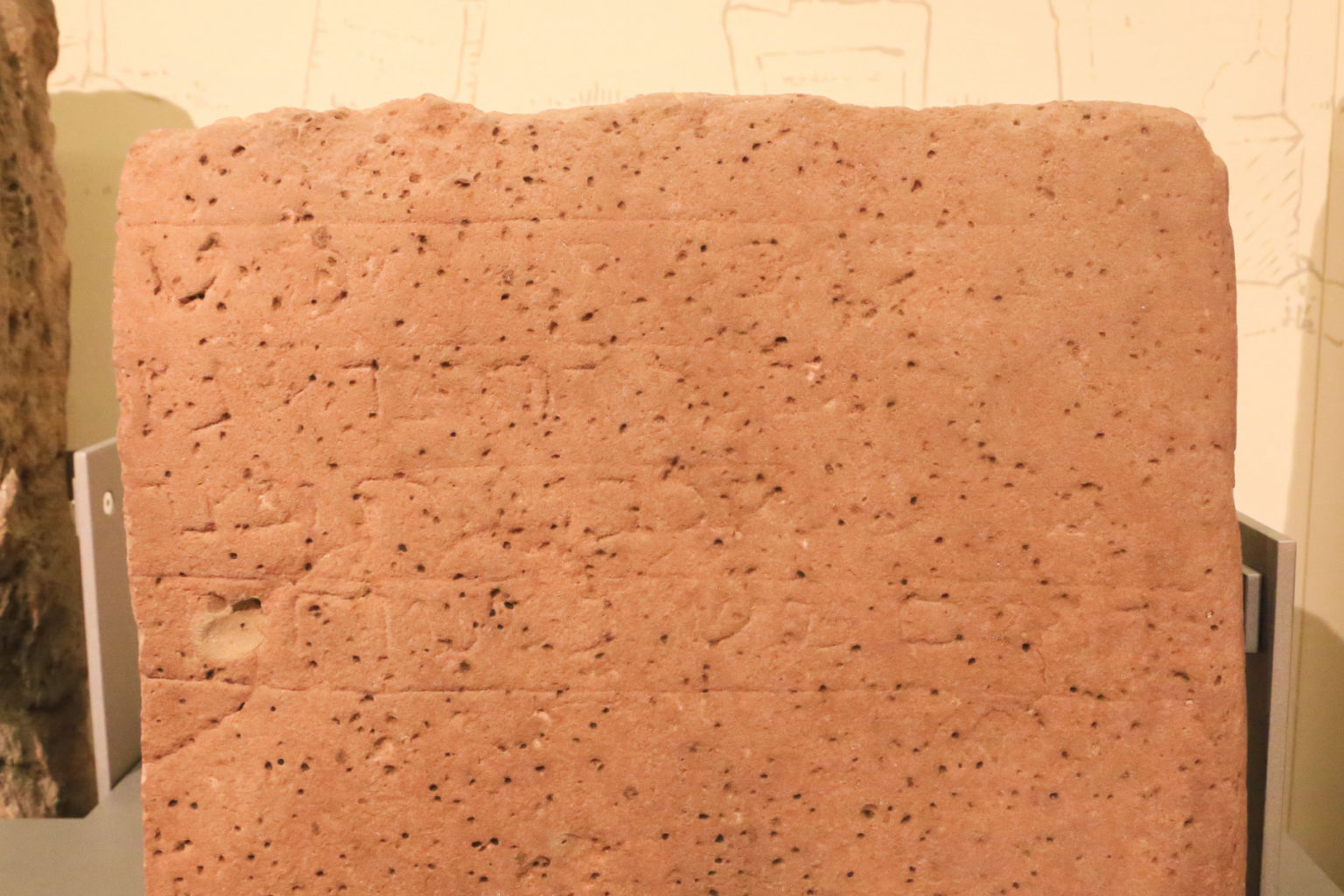
The oldest known Jewish gravestone north of the Alps was found in Mainz and dated to 1049 AD Source
Upon closer examination it appears that there were some Jews in England before 1066 after all:
The discovery, “...during the course of excavations in England, of coins minted in Judea in the first and second centuries. Whoever brought them - Roman legionaries or Jewish captives - it is probable that trade and traders went between the two provinces by the same route that was followed by these insignificant relics. There is accordingly good reason to believe that the greater urban centres in Britain harboured, if not organized Jewish communities, at least some nucleus of Jewish population. St. Jerome, in the fourth century, certainly thought so; and, in more than one passage of his writings, he specifically referred to the extension of the Diaspora as far as this remote island province, and to the conviction of the Jews of his day that their co-religionists would be gathered even thence at the time of the great final Deliverance. [Commentary to Isaiah lxvi. 20, Amos viii. 12, and Zephaniah ii. 8 (g) (Migne, Patrologia Latina,-xxiv. 672, xxv.- 1083, 1364)]. The phrasing makes it clear that Jerome believed Jews to be living in Britain and even to have attained positions of dignity there: he mentions the province together with Spain, Italy, Gaul, &c., where they were indubitably settled in his day... unless Jerome was referring to someone else, not the 'Jews' as we know them today. [Please see the updated articles mentioned above for clarification of this point.]
“In the Saxon period the Jewish traders,· then so important in the Mediterranean world and on the Continent of Europe ~ may have extended their activities as far as the British Isles, but all the evidence formerly adduced in support of this hypothesis is apocryphal. Whether or no individuals visited the country, it may be stated with confidence that no permanent settlement was formed, no community established, and no synagogue built." Source: 'A History of the Jews in England by Cecil Roth, 1964
The subject of a pre-conquest Jewish presence in England will arise again in Part 2 of this series.
In the Nature of the Beast series of articles I attempted to show that there has been a secret cult hidden deep within or behind Judaism since its inception. This cult uses Judaism for its own purposes. At various times glimpses of this cult have emerged from within the mainstream religion: the Ashkenazi and Zionism for example. The most indicative of the secret cult’s true nature is Sabbatean-Frankism. It was instigated by the Jewish Kabbalists and is the equivalent of satanism, but in a Jewish context. The Sabbatean-Frankists deliberately infiltrate other religions, cults and organisations in order to subvert them. Their trademark can be seen within socialism/communism, Freemasonry, the Hollywood cult, the mafia, the Jesuits, the WHO, the media monopoly, unregulated immigration promoters and many many more institutions.
The everyday, normal Jewish person is mostly unaware of this or at best, sees it as anti-semitic persecution. What follows exposes the agenda of this secret internal cult as it played out through Judaism. Any perceived hostility is aimed at this cult, not at the Jewish faith/people.
“Localism was close to the heart of northern European Jews who thought of themselves as belonging to a town more than to a region... From the archives of Charlemagne’s son, Louis the Pious (died 840 AD), we have three Latin charters of privilege that he issued to Jewish international merchants whom he encouraged to trade in the empire [Rhineland-Palatinate, Germany] by offering them incentives of toll exemptions. He also promised them protection directly from his own court.
“The private charters that Louis issued to individual Jewish merchants became the model for later community charters of protection that began to appear in 1084 for the newly founded Jewish community of Speyer, a spin-off of the earlier ones of Mainz, settled in the late tenth century, and Worms, settled perhaps a few decades later. In his Latin charter, Rüdiger, bishop of Speyer, notes that he was welcoming Jews who might want to settle in his town. A Hebrew account tells us that a fire had broken out in Mainz and Jews there were homeless. Rüdiger offered the Mainz Jewish refugees his personal protection, self-government, and even a strong wall around their area of settlement, so that Christian commercial competitors in town would not be tempted to harm their new Jewish neighbors. Rüdiger invited them to settle in Speyer because he thought the Jews could help him increase the prestige of Speyer by making a village into a town.
In fact there is a Jewish cemetery dating back to the 11th century in Worms. Germany, called Heiliger Sand. Its oldest gravestone dates back to 1058. The last internment took place in 1940 "in the middle of the Holocaust. Somehow, the cemetery survived World War II" Source . Which is very odd. It is apparently a site of pilgrimage for Jews from all around the world, as are the ShUM Cities themselves.
“Many other rulers invited Jews into northern Europe in the eleventh and twelfth centuries and confirmed their protection and utility to the kingdom, usually as international merchants, with similar community charters. During these times, Jews and Christians generally got along, and the settled life in towns like Mainz in the Rhineland or Troyes in the County of Champagne saw the emergence of an early rabbinic elite that was part of the commercial middle class the Jewish settlers were forming.” Source
So, we have Christian bishops inviting Jewish immigrants into Christian settlements, isolating them from the rest of the town, then giving them special treatment and protection, thus creating a ‘rabbinic elite.’ Does this sound crazy to you? It’s no wonder they needed protection.
“In the eleventh and twelfth century... a traumatic event took place, generating a religious ideology that would shape not just the elite that constructed it but also the entire culture of Ashkenaz for all time. "Ashkenaz was the Jewish term that in the Middle Ages applied only to German lands, the term eventually included northern France and England as well as northern Italy and parts of Central Europe like Bohemia. As Jews migrated into the Polish–Lithuanian Commonwealth, the term broadened to include East European Jews as well. Jews of early Ashkenaz brought their spoken German dialect of Yiddish as well as local customs and practices of Jewish living into Slavic territories.” Source
“In small rabbinical circles in northern Europe, Rabbi Shelomoh ben Yitsḥak Troyes (d. 1105), known as Rashi, wrote his running commentary to most of the Hebrew Bible and to the Babylonian Talmud. [FN: Either that or he simply created it all.] They are both still widely studied today. Rashi’s grandsons.. built a major intellectual palace of synthesis on the basis of Rashi’s Talmudic commentary… The intellectual achievement of these Tosafists (Talmud glossators) resulted in the expansion of new categories of Jewish law and practice, in effect making a formerly Mediterranean and Islamic Jewish culture into the Jewish culture of northern Christian Europe or Ashkenaz.” Source
This presents a rabbinic elite of middle-class merchants who invent a new Judaic ideology that redefines the entire culture of northern Christian Europe (Ashkenaz) for all time. The dating of this event coincides with the arrival and establishment of Jewish communities in northern Europe, in spite of the unsubstantiated claims that they arrived with the ‘Romans.’ Could this be an invasion of Ashkenaz – northern Europe - and/or the origin of Zionism? Does the rabbit hole go even deeper?* Were the Roman Catholic clergy in on it? There’s that Roman word again... or is it Norman? Did the Jews actually arrive with the Romans, not the Biggus Dickus hail Caesar ones, but the Catholic ones - the Norman Catholics?
*Update Nov. 2022: This all took place just after the 10th century cataclysm. Was it the invention or re-invention of the 'Jews'?
Meanwhile, back in Albion… After the nation had been thoroughly destabilised by the [10th century cataclysm,] early Christian proto-Jesuit Roman Catholic missionaries and Norman infiltration, they were ripe for a takeover – enter William The Conqueror and ‘his Jews’ in 1066.
The Betrayal of Albion Part 1: The City of London
The Betrayal of Albion Part 2: 1066 and all that Bollocks
The Betrayal of Albion Part 3: The English Revolution
The Betrayal of Albion Part 4: The Great Fire of London
The Betrayal of Albion Part 5: The Dutch Puppetmasters
The Betrayal of Albion Part 6: The Glorious Revolution
The Betrayal of Albion Part 7: Conclusion & Modus Operandi
Felix Noille
.
IF YOU ARE SEEING A LINK TO MOBIRISE, OR SOME NONSENSE ABOUT A FREE AI WEBSITE BUILDER, THEN IT IS A FRAUDULENT INSERTION BY THE PROVIDERS OF THE SUPPOSEDLY 'FREE' WEBSITE SOFTWARE USED TO CREATE THIS SITE. THEY ARE USING MY WEBHOSTING PLATFORM FOR THEIR OWN ADVERTISING PURPOSES WITHOUT MY CONSENT. TO REMOVE THESE LINKS I WOULD HAVE TO PAY A YEARLY FEE TO MOBIRISE ON TOP OF MY NORMAL WEBHOSTING EXPENSES - WHICH IS TANTAMOUNT TO BLACKMAIL. I CALCULATE THAT THEY CURRENTLY OWE ME THREE MILLION DOLLARS IN ADVERTISING REVENUE AND WEBSITE RENTAL.